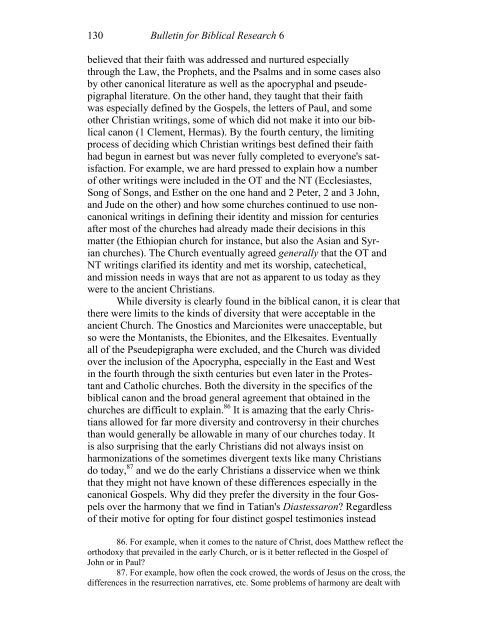The Integrity of the Biblical Canon in Light of Its Historical ...
The Integrity of the Biblical Canon in Light of Its Historical ...
The Integrity of the Biblical Canon in Light of Its Historical ...
Create successful ePaper yourself
Turn your PDF publications into a flip-book with our unique Google optimized e-Paper software.
130 Bullet<strong>in</strong> for <strong>Biblical</strong> Research 6<br />
believed that <strong>the</strong>ir faith was addressed and nurtured especially<br />
through <strong>the</strong> Law, <strong>the</strong> Prophets, and <strong>the</strong> Psalms and <strong>in</strong> some cases also<br />
by o<strong>the</strong>r canonical literature as well as <strong>the</strong> apocryphal and pseudepigraphal<br />
literature. On <strong>the</strong> o<strong>the</strong>r hand, <strong>the</strong>y taught that <strong>the</strong>ir faith<br />
was especially def<strong>in</strong>ed by <strong>the</strong> Gospels, <strong>the</strong> letters <strong>of</strong> Paul, and some<br />
o<strong>the</strong>r Christian writ<strong>in</strong>gs, some <strong>of</strong> which did not make it <strong>in</strong>to our biblical<br />
canon (1 Clement, Hermas). By <strong>the</strong> fourth century, <strong>the</strong> limit<strong>in</strong>g<br />
process <strong>of</strong> decid<strong>in</strong>g which Christian writ<strong>in</strong>gs best def<strong>in</strong>ed <strong>the</strong>ir faith<br />
had begun <strong>in</strong> earnest but was never fully completed to everyone's satisfaction.<br />
For example, we are hard pressed to expla<strong>in</strong> how a number<br />
<strong>of</strong> o<strong>the</strong>r writ<strong>in</strong>gs were <strong>in</strong>cluded <strong>in</strong> <strong>the</strong> OT and <strong>the</strong> NT (Ecclesiastes,<br />
Song <strong>of</strong> Songs, and Es<strong>the</strong>r on <strong>the</strong> one hand and 2 Peter, 2 and 3 John,<br />
and Jude on <strong>the</strong> o<strong>the</strong>r) and how some churches cont<strong>in</strong>ued to use noncanonical<br />
writ<strong>in</strong>gs <strong>in</strong> def<strong>in</strong><strong>in</strong>g <strong>the</strong>ir identity and mission for centuries<br />
after most <strong>of</strong> <strong>the</strong> churches had already made <strong>the</strong>ir decisions <strong>in</strong> this<br />
matter (<strong>the</strong> Ethiopian church for <strong>in</strong>stance, but also <strong>the</strong> Asian and Syrian<br />
churches). <strong>The</strong> Church eventually agreed generally that <strong>the</strong> OT and<br />
NT writ<strong>in</strong>gs clarified its identity and met its worship, catechetical,<br />
and mission needs <strong>in</strong> ways that are not as apparent to us today as <strong>the</strong>y<br />
were to <strong>the</strong> ancient Christians.<br />
While diversity is clearly found <strong>in</strong> <strong>the</strong> biblical canon, it is clear that<br />
<strong>the</strong>re were limits to <strong>the</strong> k<strong>in</strong>ds <strong>of</strong> diversity that were acceptable <strong>in</strong> <strong>the</strong><br />
ancient Church. <strong>The</strong> Gnostics and Marcionites were unacceptable, but<br />
so were <strong>the</strong> Montanists, <strong>the</strong> Ebionites, and <strong>the</strong> Elkesaites. Eventually<br />
all <strong>of</strong> <strong>the</strong> Pseudepigrapha were excluded, and <strong>the</strong> Church was divided<br />
over <strong>the</strong> <strong>in</strong>clusion <strong>of</strong> <strong>the</strong> Apocrypha, especially <strong>in</strong> <strong>the</strong> East and West<br />
<strong>in</strong> <strong>the</strong> fourth through <strong>the</strong> sixth centuries but even later <strong>in</strong> <strong>the</strong> Protestant<br />
and Catholic churches. Both <strong>the</strong> diversity <strong>in</strong> <strong>the</strong> specifics <strong>of</strong> <strong>the</strong><br />
biblical canon and <strong>the</strong> broad general agreement that obta<strong>in</strong>ed <strong>in</strong> <strong>the</strong><br />
churches are difficult to expla<strong>in</strong>. 86 It is amaz<strong>in</strong>g that <strong>the</strong> early Christians<br />
allowed for far more diversity and controversy <strong>in</strong> <strong>the</strong>ir churches<br />
than would generally be allowable <strong>in</strong> many <strong>of</strong> our churches today. It<br />
is also surpris<strong>in</strong>g that <strong>the</strong> early Christians did not always <strong>in</strong>sist on<br />
harmonizations <strong>of</strong> <strong>the</strong> sometimes divergent texts like many Christians<br />
do today, 87 and we do <strong>the</strong> early Christians a disservice when we th<strong>in</strong>k<br />
that <strong>the</strong>y might not have known <strong>of</strong> <strong>the</strong>se differences especially <strong>in</strong> <strong>the</strong><br />
canonical Gospels. Why did <strong>the</strong>y prefer <strong>the</strong> diversity <strong>in</strong> <strong>the</strong> four Gospels<br />
over <strong>the</strong> harmony that we f<strong>in</strong>d <strong>in</strong> Tatian's Diastessaron? Regardless<br />
<strong>of</strong> <strong>the</strong>ir motive for opt<strong>in</strong>g for four dist<strong>in</strong>ct gospel testimonies <strong>in</strong>stead<br />
86. For example, when it comes to <strong>the</strong> nature <strong>of</strong> Christ, does Mat<strong>the</strong>w reflect <strong>the</strong><br />
orthodoxy that prevailed <strong>in</strong> <strong>the</strong> early Church, or is it better reflected <strong>in</strong> <strong>the</strong> Gospel <strong>of</strong><br />
John or <strong>in</strong> Paul?<br />
87. For example, how <strong>of</strong>ten <strong>the</strong> cock crowed, <strong>the</strong> words <strong>of</strong> Jesus on <strong>the</strong> cross, <strong>the</strong><br />
differences <strong>in</strong> <strong>the</strong> resurrection narratives, etc. Some problems <strong>of</strong> harmony are dealt with
















